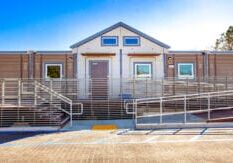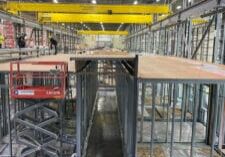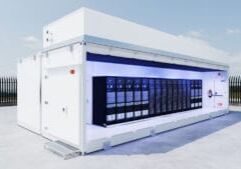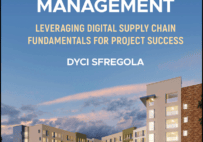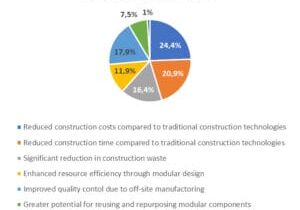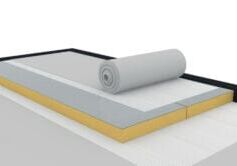“Obsession” with Modular Logistics Leads to Business Success

Carson Holmquist is the co-founder and CEO of Stream Logistics and Stream Modular.
Carson Holmquist admits he’s “obsessed” with modular logistics. The co-founder and CEO of Stream Logistics and Stream Modular is working hard to further the reach of modular construction by making transportation of modules easier and faster. His company is investing real dollars, $50 million over the next 25 years, to develop his company’s skills and provide the equipment and assets to make this dream a reality.
Holmquist began his career in logistics when he was in college at Arizona State University and was an intern for a start-up logistics company. “The industry was full of exciting challenges and there were a lot of different roads you could take within it,” he says. He was interested in the start-up business model and in 2012 decided to go into logistics with a business partner whom he’d met in school. Stream Logistics was born.
From the start they focused on what Holmquist calls “high stakes freight." These deliveries are very time sensitive, as many have crews and equipment waiting for them and they require specialized preparation and planning, much like in the modular industry. As the company performed more modular deliveries, they began to see a real need for specialization and improvements based on lessons they’d learned. So, in January 2023 they started a new division of Stream Logistics: Stream Modular, whose focus is solely on transporting freight for the modular construction industry.
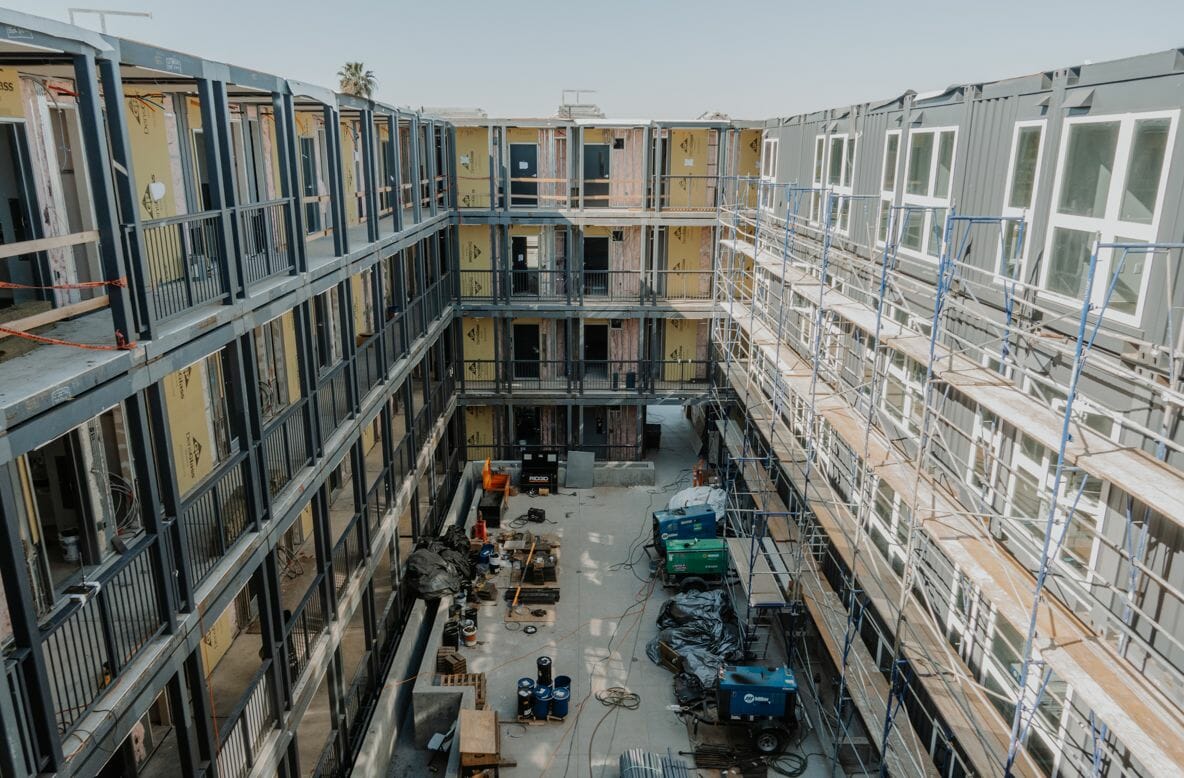
The interior plaza progress of the Hope Project, a modularly constructed low-income apartment complex in downtown Los Angeles, showcases the project undertaken by Silver Creek.
New Technologies and Lessons Learned
In the short time they’ve been in business, the team has learned a lot about modular transportation, learning more in four months than they had the last two years without the specialized focus. The team is made up of experienced logistics project managers who are revolutionizing how modular freight is handled through new technologies and lessons learned through experience.
One of the new technologies that’s improving efficiency is a specially designed trailer that allows teams to load and unload modules without the use of a crane. Modules are usually stored on jack stands or cribbing, and the specialized trailer is driven underneath this support structure. Then hydraulic pistons raise the trailer bed until the module is above the cribbing, and the truck drives off. The reverse happens when the module is delivered: the trailer bed is raised until it is above the height of the cribbing, the cribbing is installed, and then the trailer is lowered. This puts less stress on the structure of the module, preventing drywall cracks and popped nails, and it’s faster than a traditional crane lift. Holmquist and his team have learned many valuable lessons through their experiences, including the value of having boots on the ground in the first few days of a project. Most logistics companies don’t invest this additional time and cost into their projects, which can cause delays as drivers and construction crews have to deal with the fallout. Stream sends one to two project managers to the site, both before delivery starts to scope out the details, and during the first few days to help with last-minute glitches.
“We just did one in Minnesota where two of our project managers were on site for three days for the launch of a project. It was invaluable for them to be there, because if a project’s going to experience challenges, it’s most often in the first third of the project, when the pace and the rhythm is getting set.” The stuff that can really bog up the work is timing. Delays can be caused by manufacturing issues, weather, supply chain issues, and labor shortages. The team must always be prepared for delays and build them into their plans.
Holmquist recounts his first off-site panel construction project, where they were taking the panels from Arizona to Florida without a staging yard, so everything had to be just-in-time delivery. The team designed transit buffers, where every truck showed up a day and a half early and parked and waited in a lot that was less than 10 miles away from the job site. This allowed them to keep up with the deliveries and even get ahead if the installation crew allowed them to. The strategy proved successful.
On another project the project manager performed a site survey and found stored inventory, portable restrooms, and a fire hydrant in the way of the truck approach. The inventory and restrooms could be moved before the first delivery arrived, but the fire hydrant would be difficult to see in a large truck. The team attached a PVC post with a flag on top so the truck could always see it.
Without careful planning and visiting the project before deliveries start, both of these projects could have turned out much worse, costing everyone time and money. “This industry requires the best of our capabilities, which is really exciting and means with every project we’re going to grow and get better. And it also shows us that this industry needs something really special, something that the rest of the transportation industry wouldn’t intuitively know to do."
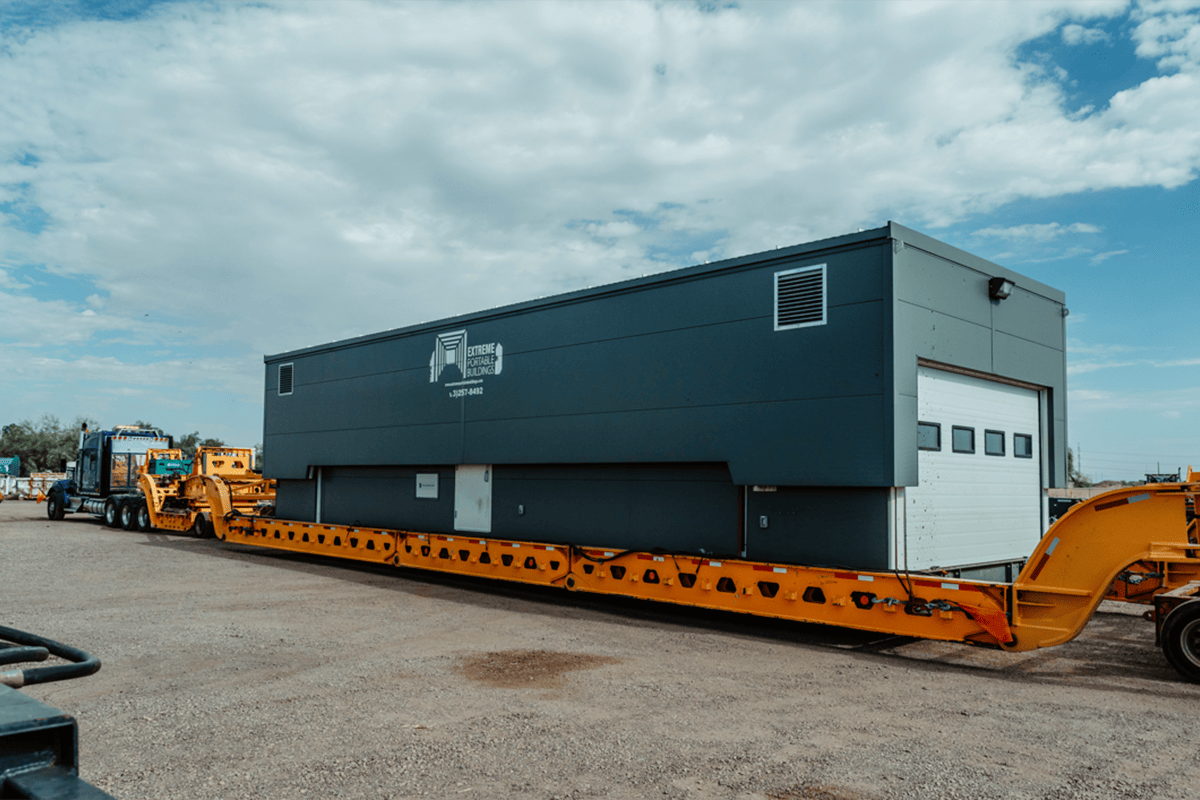
A massive modular industrial space for Extreme Modular Buildings is delivered from Sturgess, South Dakota to Phoenix, AZ, highlighting the transportation stage of the project.

Another phase of the Silver Creek project captures the readiness of a module to be craned and placed onto a modularly built low-income apartment complex in Downtown Phoenix.
Getting Involved Early
Holmquist says the best time for his team to get involved is during budgeting. “We’ve seen so often a factory will come to us, we design a plan, then they realize their original budget wasn’t anywhere near close. And that’s a difficult position to be in because it’s going to eat into the margin of the project.” A couple of months before the project begins, the team begins to nail down the details of the job, including what permits are needed, routes to take, and timing of deliveries. Then, a couple of weeks before the first deliveries are made, the team really kicks it into gear.
Because of the different jurisdictions and requirements for transporting large loads, getting specific information about the job, including exact addresses, is key. Some highways have timing restrictions for large loads, so delays of even an hour can significantly affect the delivery schedule. The team must plan exact routing and timing to meet the production crew’s schedule, as the delivery schedule is determined by how many units they can install during a workday. All of this drives the need for resources: drivers, trucks, trailers, etc.
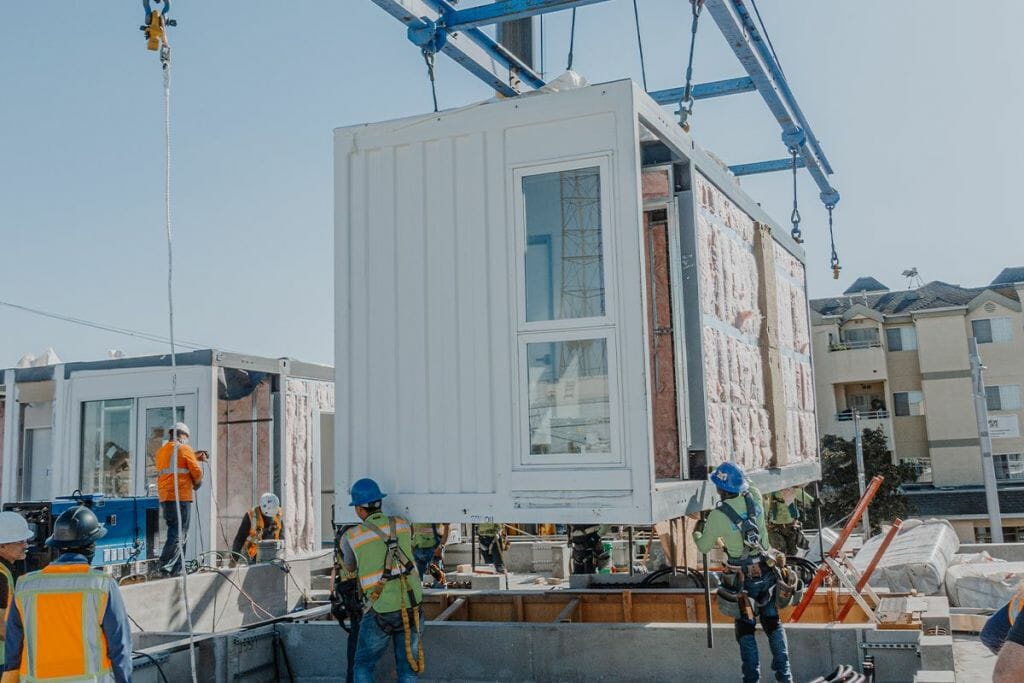
The “Hope Project” by Silver Creek reaches the craning and setting phase, illustrating the module being placed atop an apartment complex as part of the construction process.
Transportation Best Practices
Holmquist urges owners and manufacturers to invest in their delivery relationships the way they invest in their contractors and designers. “It’s very common for the factories to have strategic conversations with the construction crew. They probably happen dozens of times throughout the course of a project. It’s very uncommon to include the transportation company in those conversations.” Teams often don’t realize that small details, like the width of a unit, can have a significant effect on transportation costs and schedule.
Working as a team, factory, construction contractor, and transportation company, is key to project success. “It’s one unitary
process, a cycle, and so working together is very important. And it’s important to find a transport partner that’s looking to co-create solutions for the future of your company. This means it’s not just about this project today, it’s about investing in what’s needed to ensure that we’re getting where we want to go. Another best practice is to “make a commitment to maintain impeccable communication. So as soon as something changes, as soon as you have information, it’s passed down the chain to that critical team."
Making a Commitment to the Industry
“We want to help accelerate the adoption of modular construction. And we know that transportation can be a big impediment to the experience that the general contractors or the developers have. What we want to do is make sure they come back and do it again. The way transportation’s being done now needs to meet the demands of today, but we also have to keep an eye on the future and what needs to be developed to close that gap between now and where this industry is going. And we’re fully committed to it."
About the Author: Dawn Killough is a freelance construction writer with over 25 years of experience working with construction companies, subcontractors and general contractors. Her published work can be found at dkilloughwriter.com.
More from Modular Advantage
Resia: Breaking All the Rules
Resia Manufacturing, a division of U.S.-based Resia, is now offering prefabricated bathroom and kitchen components to industry partners. Its hybrid fabrication facility produces more precise bathroom and kitchen components (modules) faster and at lower cost than traditional construction. Here’s how Resia Manufacturing does it.
How LINQ Modular Innovates to Bring Modular To The Market in the UAE and Beyond
LINQ Modular, with an office and three manufacturing facilities in Dubai, is a modular firm based in United Arab Emirates. The company is on a mission: to break open the housing and construction markets in the Gulf Cooperation Council (GCC) area with modular.
ModMax: Redefining Modular Construction with Confidence and Precision
ModMax was born out of frustration—frustration with five persistent pain points in modular construction: Permitting bottlenecks. Production delays. Rigid designs. Disconnect between “the office” and the field. Lack of transparency and communication.
LifeArk: Disaster-Resilient Housing from Recycled Plastic and 100-year-old Technology
Wee compares LifeArk’s housing units to Yeti coolers, as they are built similarly. Each component takes 15 to 20 minutes to manufacture, has an R-value of 40, and includes molded slots and chases for wiring, plumbing, fire sprinklers, and other utilities.
Building the Future of Modular Edge Infrastructure
The edge data center market is expanding rapidly, driven by the surge in AI workloads, IoT adoption, and the need for localized compute power. In these environments, sustainability, scalability, and reliability are non-negotiable. Cooling is among the most complex challenges for operators—and one of the most decisive factors in long-term success.
Accelerating Light-Gauge Steel Construction: A Semi-Automated Digital Workflow for Off-Site Projects
For construction professionals, the message is clear. By adopting semi-automation and digitalization, companies can deliver projects faster, more accurately, and more profitably, while also building stronger collaboration across teams. The approach is not about replacing people with machines, but about empowering people with better tools and processes.
Why Modular Data Centers Are Gaining Momentum
Artificial intelligence, high-performance computing, and edge applications push the limits of traditional “stick-built” data centers. They take years build, often struggle with high density workloads, and aren’t optimized for deployments near end users. Modular data center platforms are purpose-built to address these challenges, offering flexibility and scalability to adapt to evolving technologies, while opening new opportunities for the modular construction industry.
Supply Chain Innovation in Action: 5 Habits Every Modular Leader Should Practice
By applying these principles to supply chain practices — collaborative planning, strategic procurement, scenario modeling, digital tools, and transparent forecasting — construction leaders can build value chains that are not just efficient and agile, but truly innovative.
Exploring the Role of Modular Integrated Construction (MiC) in Advancing Circular City Principles – A Survey of Stakeholder Perspectives
The survey findings highlight the significant potential of Modular integrated Construction (MiC) in advancing the development of circular cities. By reducing costs, accelerating construction timelines, and minimizing waste generation, MiC offers a promising approach to sustainable urban development.
The Use of MS POLYMER™-Based Sealants and Adhesives in Modular Building
These products combine flexibility and elastic recovery with excellent adhesion to different substrates and have already shown their usefulness in traditional construction. Now it’s time for them to be put to use in the modular construction industry.




